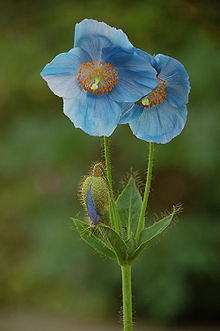- Meconopsis
-
Meconopsis 
Blue Poppy (Meconopsis sp.) Scientific classification Kingdom: Plantae Division: Magnoliophyta Class: Magnoliopsida Order: Ranunculales Family: Papaveraceae Genus: Meconopsis
Vig.Species Including:
M. aculeata
M. autumnalis
M. betonicifolia (Himalayan blue poppy)
M. cambrica (Welsh poppy)
M. chelidonifolia
M. grandis
M. lancifolia
M. manasluensis
M. napaulensis (Nepal poppy)
M. punicia
M. quituplinerva
M. simplicifolia (blue poppy)Meconopsis is a genus of flowering plants in the family Papaveraceae. The species have attractive flowers and have two distinct ranges. A single species, Meconopsis cambrica (Welsh poppy), is indigenous to England, Wales, Ireland, and the fringes of Western Europe. The other 40 or so (depending on classification) species are found in the Himalayas. Within the Himalayan types there is much debate as to what constitutes a particular species as many readily hybridise with each other and produce viable seed. It is likely that some individually-named species are in fact a single species but with an under-appreciated morphological diversity.
A large proportion of species are monocarpic and as such are notoriously difficult to maintain in cultivation.
Meconopsis grandis, nicknamed the Blue Poppy (although it is only poppy-like), is the national flower of Bhutan. In the late spring of 1922, a British Himalayan expedition, led by legendary mountaineer George Leigh Mallory, discovered the plant on their failed attempt to reach the summit of the then-unconquered Mount Everest. The flowers were introduced to much excitement at the Royal Horticultural Society's spring show of 1926. However, since they are difficult to grow, the species has become fabled over the decades. In 2009, horticulturalist and author Bill Terry published his "gardening memoir", Blue Heaven, about the plant.
In June 2007, Hale Books published the novel "Dreams of the Blue Poppy" by English author Angela Locke. The book's central theme concerns a sickly child who dreams of finding the fabled plant and ends up on a journey of both personal and botanical discovery to the Indian Himalaya. [1]
Cultivation
Himalayan varieties have the reputation for being difficult to grow from seed, but when germinating new plants, using fresh seeds will help. On the other hand, the Welsh poppy is sometimes considered a weed, albeit a handsome one, due to its vigorous self-seeding. It comes as a surprise to many that poppies are available in shades of blue. These plants are available in a variety of strong colours, including blue, red, orange, purple, white and yellow depending on species and cultivar.
Sources and references
- Meconopsis.org specialized website - includes further links
- Meconopsis World - A Visual Reference - identification guide to species using photographs of wild plants
Categories:- Papaveraceae genera
Wikimedia Foundation. 2010.
